When wind turbines catch the wind's energy, they create electricity. Solar panels trap sunlight and turn it into power. These sources fuel homes, businesses, and even entire areas with renewable energy. The process is clean and sustainable, benefiting the environment. The use of wind and solar energy continues to grow, reshaping the energy landscape. If curious about how these technologies work in-depth and the impact they have on the economy and job market, there is much more to explore in the domain of renewable energy generation.
Key Takeaways
- Wind turbines convert kinetic energy into electricity.
- Solar panels use photovoltaic cells to generate electricity from sunlight.
- Wind farms and solar arrays contribute to renewable energy.
- Photons interacting with semiconductor materials create solar power.
- Renewables like wind and solar reduce dependency on traditional fossil fuels.
Wind Turbines: Kinetic Energy Conversion
Wind turbines efficiently convert the kinetic energy of wind into electricity by harnessing the rotation of turbine blades. As the wind turns the blades, a generator inside the turbine produces electricity. This electricity is then transmitted through power lines to homes and businesses, providing a clean and renewable source of power.
Wind power, generated from wind turbines, plays a significant role in the production of electricity. Onshore and offshore wind farms capture the energy of the wind, allowing for the generation of large amounts of electricity.
In the United States, over 65,000 wind turbines have been installed, with Texas leading the country in wind energy production. The total wind power capacity in the U.S. has exceeded 100 gigawatts, making wind energy an essential contributor to the electricity grid, supplying power to millions of households.
The continuous advancement in wind turbine technology further enhances the efficiency and reliability of wind power generation.
Solar Panels: Photovoltaic Electricity Production
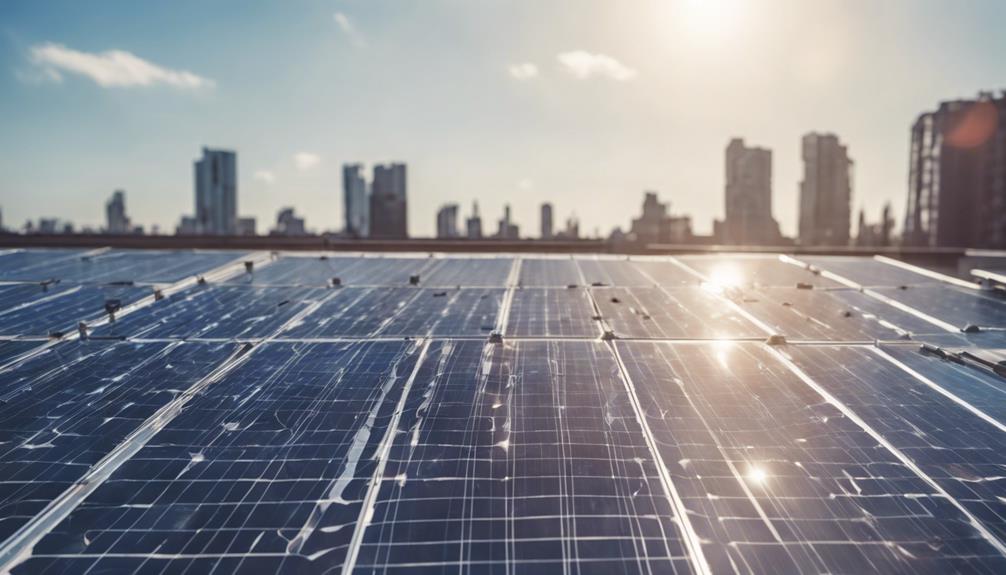
Solar panels work by harnessing the power of sunlight through photovoltaic cells. These cells convert sunlight into electricity. The photons in sunlight interact with the semiconductor material in the panels, causing electrons to flow and generate an electric current.
This process allows solar panels to efficiently produce electricity from the sun's energy. It makes them a valuable source of renewable power.
Solar Panel Technology
Using semiconductor materials like silicon, photovoltaic cells in solar panels directly convert sunlight into electricity. These cells absorb sunlight, releasing electrons that generate an electric current.
When sunlight strikes a solar panel, the photovoltaic cells initiate a process that produces electricity. This electric current can then be used to power homes, businesses, and even entire cities.
Solar panels are designed to generate electricity efficiently, making them a reliable source of renewable energy. Even on cloudy days, solar panels can still produce electricity, although their efficiency may be slightly reduced compared to sunny days.
Over the years, advancements in solar panel technology have notably improved their efficiency and durability. This progress has made solar panels a cost-effective and sustainable solution for harnessing energy from the sun.
Embracing solar panel technology can contribute to a cleaner and greener future by reducing reliance on fossil fuels.
Photovoltaic Energy Conversion
Through the photovoltaic effect, solar panels efficiently convert sunlight into electricity by freeing electrons from atoms, generating an electric current. This process takes place within solar cells, typically composed of semiconductor materials like silicon.
When sunlight strikes the solar panels, photons dislodge electrons in the semiconductor material, creating an electric field that enables the flow of electrons. As a result, direct current (DC) electricity is produced.
To make this electricity usable for homes and businesses, inverter systems are employed to convert the DC electricity into alternating current (AC) electricity. The efficiency of solar panels can vary, with modern panels converting approximately 15-22% of sunlight into electricity.
This electricity conversion process plays an essential role in harnessing solar energy and making it a viable renewable energy source for powering various applications.
NASA and Solar Panels: A Historical Perspective

In the domain of space exploration, NASA's utilization of solar panels dates back to the 1950s, pioneering the integration of this innovative technology into satellite power systems. The historical use of solar panels by NASA showcases the early adoption of solar energy technology for generating electricity from sunlight. Over the years, solar panels have evolved to become more efficient and cost-effective, enabling advancements in space missions and satellite operations. The integration of solar panels in NASA's projects highlights the versatility and reliability of this renewable energy source.
| Solar Panels | Solar Energy Technology | Historical Use |
|---|---|---|
| Generating Electricity | Sunlight | NASA's Pioneering Applications |
| Satellite Power Systems | Efficiency | Evolution Over Time |
| Space Exploration | Reliability | Impact on Space Missions |
Utility-Scale Installations: Grid Electricity Generation
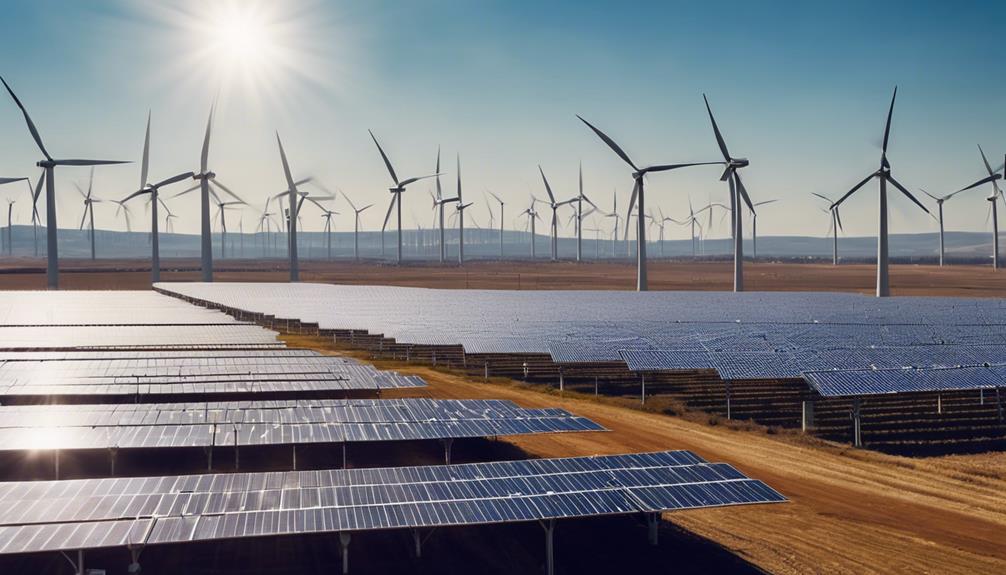
NASA's historical use of solar panels for satellite power systems paved the way for the widespread adoption of utility-scale wind and solar installations in generating electricity for the grid. These utility-scale installations play a pivotal role in grid electricity generation by harnessing renewable sources like wind power and solar systems.
By utilizing large turbines and arrays, these installations efficiently convert wind and sunlight into electricity that's fed directly into the grid. In the United States, utility-scale concentrated solar systems and photovoltaic systems work in tandem to contribute to the energy mix. Unlike rooftop solar installations that cater mainly to on-site electricity needs, utility-scale installations have a broader impact by providing power to the grid.
With onshore and offshore wind power installations diversifying the renewable energy sources available, utility-scale installations are instrumental in ensuring a sustainable and reliable supply of electricity for the grid.
U.S. Energy Landscape: Wind and Solar Power
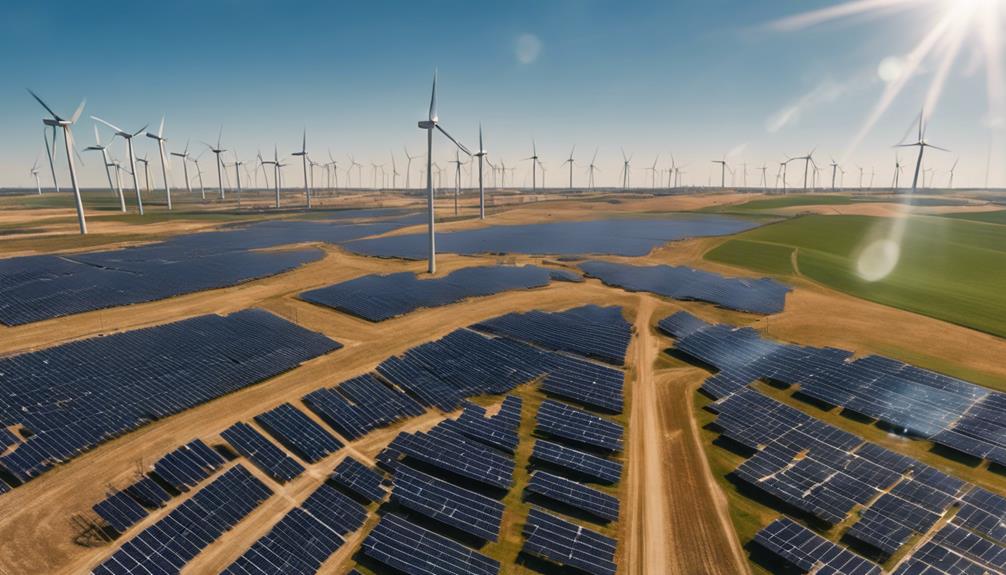
As wind and solar power continue to shape the U.S. energy landscape, their significant contributions are evident in the nation's electricity generation mix.
- Wind power generates over 10% of the country's electricity, while solar power accounts for nearly 3%.
- Wind power capacity has more than tripled in the past decade, making it one of the fastest-growing sources of electricity.
- States like California, Texas, and Florida lead in solar energy installations, showcasing the vast potential for solar power generation in the United States.
- Wind and solar power play pivotal roles in the country's renewable energy portfolio, aiding in the reduction of carbon emissions and the fight against climate change.
The integration of wind and solar power into the grid is vital for a sustainable energy future, with technological advancements driving their widespread adoption and solidifying their position as key players in the U.S. energy landscape.
Renewables and Job Creation: Economic Impact

You'll find that renewables like wind and solar power have been instrumental in creating job opportunities across the U.S. economy.
The growth in renewable energy sectors such as solar and wind power translates into tangible economic benefits and employment prospects for many Americans.
Job Growth in Renewables
With significant job growth in renewables, the solar sector employed nearly 190,000 Americans in June 2020. This increase showcases the positive impact of shifting to renewable sources like solar energy and wind power on job creation in the United States.
The wind power sector also played a significant role in supporting around 120,000 American jobs in 2019, further highlighting the economic opportunities presented by renewable energy.
Embracing renewables is projected to create between 500,000 to one million jobs by 2030, indicating a promising outlook for job growth in the renewable energy sector.
Utility-scale wind and solar power are now cheaper than coal in many U.S. states, contributing to increased job opportunities in renewables.
Renewables support more jobs per unit of electricity compared to fossil fuels, emphasizing the job creation potential of wind and solar power.
Renewable energy not only offers environmental benefits but also presents a substantial avenue for employment and economic growth in the country.
Economic Benefits of Renewables
Embracing renewable energy sources like wind and solar power can lead to noteworthy economic benefits, especially concerning job creation and overall financial growth.
The solar sector employed nearly 190,000 Americans in June 2020, demonstrating the job creation potential of renewables. Similarly, wind power supported around 120,000 American jobs in 2019, highlighting the economic impact of shifting to renewable energy sources.
It's projected that by 2030, the switch to renewables could create between 500,000 to one million jobs, contributing significantly to employment growth. Additionally, utility-scale wind and solar power are now more cost-effective than coal in many U.S. states, indicating the economic advantages of renewables.
These sources also support more jobs per unit of electricity compared to fossil fuels, underscoring the job creation potential of wind and solar power. By investing in renewables, not only are we promoting sustainability but also fostering economic prosperity through employment opportunities and cost-effective energy generation.
Transitioning to Renewables: Future Job Growth
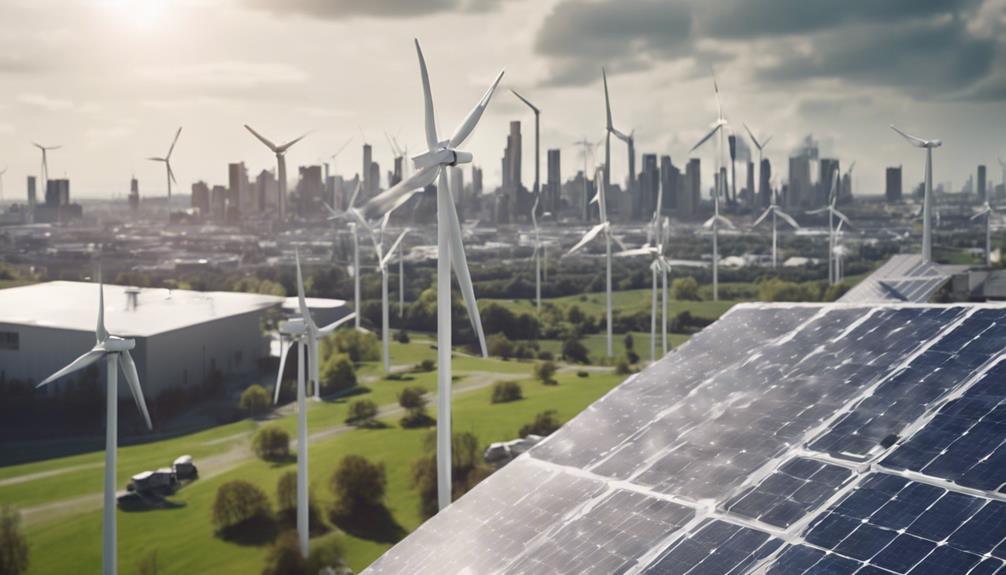
Shifting towards renewables promises significant job growth opportunities in the wind and solar power sectors by 2030. As the renewable energy industry expands, here's what you can expect regarding job growth:
- 500,000 to one million new jobs: Moving to renewables is projected to create a substantial number of job opportunities by the end of the decade.
- 190,000 jobs in the solar sector: The solar industry alone employed nearly 190,000 Americans in June 2020, highlighting the sector's job growth potential.
- 120,000 jobs in wind power: With approximately 120,000 American jobs supported by wind power in 2019, this sector offers significant employment opportunities.
- Shift towards cheaper energy: Utility-scale wind and solar power have become more cost-effective than coal in many U.S. states, driving the shift towards renewables and subsequently, job creation.
Embracing renewables not only benefits the environment but also propels job growth in these flourishing sectors.
Solar and Wind Capacity: Powering American Homes
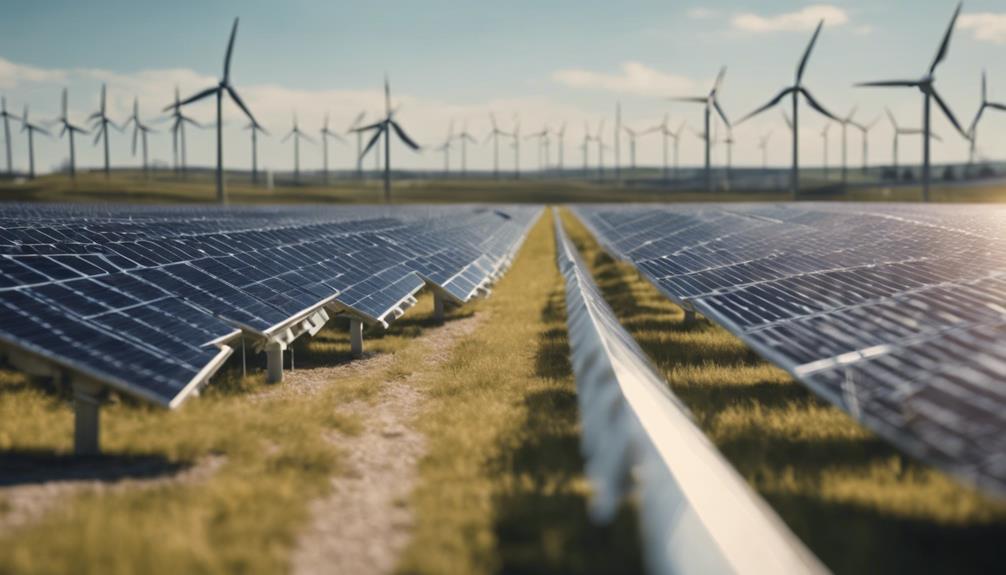
The solar and wind capacity in the U.S. is currently capable of powering millions of American homes. With a mix of rooftop solar contributing to on-site electricity needs and utility-scale installations feeding into the grid, solar and wind energy have become essential to the electricity landscape in the United States.
The significant drop in the cost of new solar capacity installations by 89% between 2009 and 2019 has made solar power more accessible and affordable for households across the country. Additionally, utility-scale wind and solar power now outcompete coal in many states, accelerating the shift towards cleaner energy sources.
The abundance of wind speeds in various regions coupled with the increasing efficiency of solar panels has enabled renewables to play a crucial role in meeting the energy demands of American homes. As renewables continue to expand, they're expected to double their electricity share by 2050, underscoring the pivotal role of solar and wind power in powering homes and businesses sustainably.
Frequently Asked Questions
How Is Wind and Solar Energy Produced?
To generate wind and solar energy, harness the power of wind through turbines converting it into electricity and capture sunlight with solar panels to produce electricity using the photovoltaic effect, enabling sustainable energy generation.
How Do You Generate Power From Solar Wind?
To generate power from solar wind, position turbines and panels strategically to capture sunlight and wind. Solar panels convert sunlight into electricity through photovoltaic cells, while wind turbines harness the kinetic energy of the wind to produce clean, renewable energy.
How Is Energy Generated From Wind?
To generate energy from wind, wind turbines capture kinetic energy from moving air. Blades spin with the wind, turning a generator to produce electricity. Wind power is clean, renewable, and helps reduce emissions.
How Is Power Generation Using Wind Turbine and Solar Energy?
Imagine the wind's dance powering your home as turbines spin and convert kinetic energy into electricity. Then, envision the sun's rays embracing your rooftop, where solar panels harness light, transforming it into power.
What are the similarities and differences in the generation of energy between wind and solar power?
Wind and solar power both harness renewable energy sources to generate electricity. They share similarities in their clean and sustainable nature, but differ in their methods of energy generation. While wind power relies on harnessing wind to turn turbines, solar power involves capturing sunlight through photovoltaic panels or a dishtype concentrated solar power system.
Conclusion
As the wind turbines spin and the solar panels soak up the sun's rays, you witness the transformation of energy happening all around you.
Like a symphony of nature's elements playing together, wind and solar power harmoniously create electricity for a brighter, cleaner future.
Embrace the power of renewable energy and be a part of this beautiful orchestra of sustainability.










